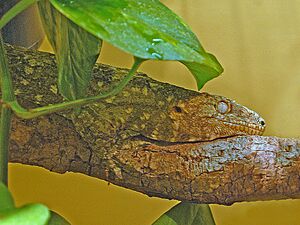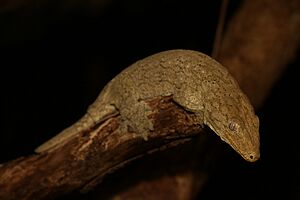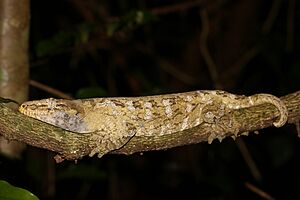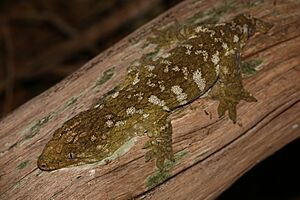New Caledonian giant gecko facts for kids
Quick facts for kids New Caledonian giant gecko |
|
|---|---|
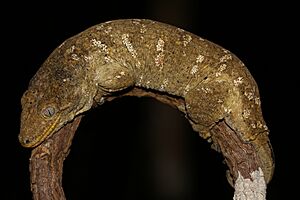 |
|
| Conservation status | |
| Scientific classification | |
| Genus: |
Rhacodactylus
|
| Species: |
leachianus
|
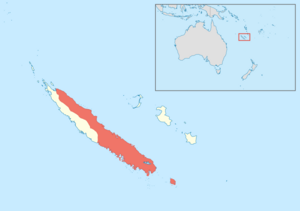 |
|
| Where the giant gecko lives (New Caledonia, Oceania)
Range |
|
| Synonyms | |
|
List
Ascalabotes leachianus Cuvier, 1829
Pteropleura leachianusGray, 1831 Lomadactylus leachianusvan der Hoeven, 1833 Gecko leachiiSchinz, 1834 Platydactylus leachianus Wiegmann, 1834 Hoplodactylus leachianus Fitzinger, 1843 Rhacodactylus leachianus Bocage, 1873 |
|
The Rhacodactylus leachianus, often called the New Caledonian giant gecko or just Leachie, is the biggest living gecko in the world. It belongs to the family Diplodactylidae. This amazing gecko naturally lives on most of New Caledonia, a group of islands in the Pacific Ocean.
Contents
- Discovering the Giant Gecko
- What Does the Giant Gecko Look Like?
- Where the Giant Gecko Lives
- Different Types of Giant Geckos
- Yate Geckos (Mainland)
- Mount Khogis Geckos (Mainland)
- Goro Geckos (Mainland)
- Poindimie Geckos (Mainland)
- Mount Humboldt Geckos (Mainland)
- Brosse Geckos (Island)
- Bayonnaise Geckos (Island)
- Nuu Ana Geckos (Island)
- Nuu Ami Geckos (Island)
- Duu Ana Geckos (Island)
- Caanawa Geckos (Island)
- Isle of Pines Geckos (Island)
- Moro Geckos (Island)
- Different Types of Giant Geckos
- Giant Gecko Life and Habits
- Local Stories
- Protecting the Giant Gecko
- Giant Geckos as Pets
Discovering the Giant Gecko
The special name, leachianus, was given to honor an English animal expert named William Elford Leach. For a while, people thought there were three different types (subspecies) of R. leachianus. These were R. l. aubrianus, R. l. henkeli, and R. l. leachianus. However, new studies of their DNA show that these geckos are all one species. Instead of subspecies, we now talk about different "morphotypes." These are groups that look a bit different depending on where they live.
What Does the Giant Gecko Look Like?
The R. leachianus is the largest gecko alive today. It's a great example of "island gigantism." This means animals on islands sometimes grow much larger than their relatives on mainlands.
Geckos from the main island of Grande Terre can grow up to 14 to 17 inches long. They can weigh between 250 and 500 grams. Geckos from the smaller islands are a bit smaller. They grow to about 9 to 12 inches long and weigh 150 to 300 grams.
This gecko has a strong body, loose skin, and a short, thick tail. Its color can change a lot. You might see them in shades of green, gray, or brown. Sometimes they have cool white, orange, or pink spots or patterns.
Long ago, there was an even bigger gecko called Gigarcanum delcourti. It was about 50% longer than the biggest Leachie. It also lived in New Caledonia but is now extinct.
Where the Giant Gecko Lives
R. leachianus lives in the southern and eastern parts of New Caledonia's main island. They also live on several smaller islands nearby. The different places they live have different landscapes and environments. This might be why the geckos look a bit different from one place to another.
One island, Duu Ana, might not have any R. leachianus left in the wild.
Different Types of Giant Geckos
R. leachianus often show different colors, sizes, and shapes depending on where they come from. These are called "morphotypes." The largest groups of R. leachianus are found on the main island of New Caledonia, called Grande Terre.
These "mainland localities" include places like Yate, Mount Khogis, Goro, Poindimie, and Mount Humboldt. In the past, people used a system of "Type A," "Type B," and "Type C" to describe them. This system is not used by scientists anymore. But you might still hear it in the pet trade.
- Type A geckos had little to no patterns on their sides. They usually had a dark, solid, or webbed background color.
- Type B geckos showed patterns on their sides. These were like lines or solid vertical bars, often on a dark background. They were said to be the most patterned.
- Type C geckos were slow-growing and large. They often had light spots on a dark background. Some Type C geckos were reported to grow up to 17 inches long!
R. leachianus are also found on the smaller "insular localities" (islands) near Grande Terre. These include the Isle of Pines, Nuu Ami, Nuu Ana, Duu Ana, Moro, Bayonnaise, Brosse, and Caanawa.
Yate Geckos (Mainland)
Geckos from the Yate region are known for being very large and heavy. They often have longer tails compared to other types. Yate geckos can weigh over 400 grams and grow up to 15 inches long. Their main color can be dark brown to golden yellow. They often have dark netting or thin web-like patterns. Sometimes, thin white lines are also on their sides.
Mount Khogis Geckos (Mainland)
Mount Khogis geckos are also among the largest. They often weigh over 300 grams. Their colors range from jet black to olive green. These geckos might have bigger scales along their snout ridges. This can help tell them apart. White spots of different sizes might also be on their sides.
Goro Geckos (Mainland)
Goro geckos are a large type, reaching up to 17 inches long and 500 grams. They are dark in color with white spots that run in vertical rows along their sides. Small white speckles might also be on their whole body.
Poindimie Geckos (Mainland)
Poindimie geckos are often longer and thinner than other mainland types. They are one of the largest, reaching over 400 grams. Their base color varies, including greens, blacks, yellows, and browns. They usually have little to no pattern. However, yellow or white spots might appear as they get older.
Mount Humboldt Geckos (Mainland)
Mount Humboldt geckos are large and bulky. Their base color can be black, brown, or green. White spots might be present, often covering their sides and sometimes their back. Mount Humboldt geckos can weigh up to 420 grams.
Brosse Geckos (Island)
Geckos from Brosse Island are considered one of the larger island types. They have a strong, robust shape. Their color is often yellow or green with large pink or white spots. They also have black flecks. This type is sometimes called the "striped neck" gecko. This is because of bars that start behind their head and go down their neck. Brosse geckos can weigh about 250 grams and measure up to 10 inches long. Brosse Island is also known as "Isle D."
Bayonnaise Geckos (Island)
Bayonnaise geckos have a yellow-green base color. They often show bands that cover their sides and back. These bands can be thin white spots or larger pink, purple, or white bands. Bayonnaise Island is also known as "Isle C."
Nuu Ana Geckos (Island)
Nuu Ana geckos are the smallest type of R. leachianus recorded. They often have shorter limbs and a robust look. Nuu Ana geckos can reach up to 9 inches long and stay under 200 grams. Their base color can be different shades of greenish yellow. They often have large colorful spots or bars all over their body. Nuu Ana Island is also known as "Isle G."
Nuu Ami Geckos (Island)
Nuu Ami geckos are a small type, reaching up to 200 grams. They often have darker gray eyes compared to other types. Their base color can be deep green to bright yellow. They commonly have white or pink spots. Nuu Ami geckos might also have spots or blotches arranged in a "W" shape on their back. Nuu Ami Island is also known as "Isle H."
Duu Ana Geckos (Island)
Duu Ana geckos have a dark green-brown base color. They have light-colored bars along their sides. Bars might also be on their back. Duu Ana geckos often have larger legs compared to other island types. People think they might eat crabs because there isn't much fruit on their island. This type is believed to be extinct in the wild. However, some small groups are still bred in captivity. Duu Ana Island is also known as "Isle I."
Caanawa Geckos (Island)
Caanawa geckos are a larger island type. Their base color varies, from browns to light green. The patterns on Caanawa geckos often show deep purple spots or bars. They also have many black speckles. Caanawa Island is also known as "Isle K."
Isle of Pines Geckos (Island)
Geckos from the Isle of Pines are the largest of the island types. They can reach up to 12 inches long and weigh over 300 grams. This type often has a large head and neck, with a strong appearance. Their base color is often deep green, but can also be brown or yellow. They have white spots on their sides and back. The Isle of Pines is also called "Pine Island."
Moro Geckos (Island)
Geckos from Moro Island are one of the largest island types. They can reach 12 to 13 inches long. The Moro type often has a green base color with large pink or white spots. Their head shape is large with a squared-off snout. Moro Island is also known as "Isle E."
Giant Gecko Life and Habits
R. leachianus are tree-dwelling animals. They are mostly active at night (nocturnal). During the day, they hide in tree hollows. Their diet includes insects, spiders, small animals, fruit, nectar, and tree sap. They often eat fruit from the Cassine curtipendula plant.
Mainland geckos have longer snouts. This suggests they might eat more small animals and insects than island geckos. Sometimes, these giant geckos have been seen eating each other. This might happen when they are defending their territory.
These geckos can climb straight up glass surfaces! This is because of special sticky pads on their feet called lamellae. These pads have tiny hairs that create a lot of grip. R. leachianus also have large claws that help them climb.
Giant geckos can drop their tails if they feel threatened. This is called autotomy. Unlike some other geckos, R. leachianus can grow their tails back. This process is called epimorphosis.
Male and female R. leachianus look a bit different. This is called sexual dimorphism. Males have a small bulge at the base of their tail, which females do not have. The temperature during egg incubation can decide if the gecko will be male or female. Eggs kept at 85°F (29°C) often become males. Eggs kept at 72°F (22°C) often become females.
Reproduction and Mating Behavior
Some gecko enthusiasts believe that R. leachianus might stay with one partner for a breeding season or even several years. In captivity, some people keep pairs together. If the geckos start fighting, they are separated.
When geckos breed, they can bite and thrash around. This can be quite rough. It's thought that this behavior might help them test if they are a good match. We don't know if this level of roughness happens in the wild. In nature, a male and female pair might live in a tree hollow. They will defend this home by making loud noises.
Adult female R. leachianus usually lay two eggs at a time. They can lay up to 10 sets of eggs (clutches) each year. Older females in captivity might not lay eggs every year. However, they can lay eggs throughout their adult life. Sometimes, a pair that used to get along might start fighting. This shows they are no longer compatible. There have been claims of females laying eggs without a male (parthenogenesis), but this has not been proven.
How Giant Geckos Communicate
R. leachianus can make more different sounds than any other gecko. They can make a loud growling noise. Local people sometimes call them "the devil in the trees" because of this sound. This growl is probably a warning call. They use it when a predator or another gecko is nearby.
Clucking is another common sound. This is often used for mate calling and is heard at night. A soft whistle sound means they are uncomfortable or a little stressed. Larger mainland geckos also make bird-like chirping sounds. When they do this, they stand tall and open their mouths wide to show they are a threat. This is often followed by a lunge.
Changing Colors for Camouflage
Many lizards can change their skin color. Chameleons are a famous example. New Caledonian Geckos can do this too. They have special cells called chromatophores that hold color. This helps them camouflage and blend into their surroundings. Many things can cause them to change color. These include their body's hormones or changes in sunlight and temperature.
Local Stories
Some of the local Kanak people in New Caledonia are afraid of Leach's giant gecko. There's an old story that says the gecko can stick to a person's body and pull out their soul.
Protecting the Giant Gecko
The number of R. leachianus has likely gone down. This is because their homes are being destroyed or damaged. This is still a big threat to them. They also face danger from animals brought to the island, like cats and rats, which might eat them. People also illegally catch them (poaching). They can also get hurt by electricity if they climb on power lines.
Luckily, this species is protected. It lives in several nature reserves where it is safe.
Giant Geckos as Pets
The New Caledonian giant gecko is sometimes kept as a pet. The geckos sold as pets are usually bred in captivity. This means wild populations are not taken from their homes. These geckos can live over 20 years as pets. Some have even lived up to 50 years!
People who breed them as pets try to keep the different types (localities) pure. They also sometimes mix different types to create geckos with special colors, sizes, or shapes.



